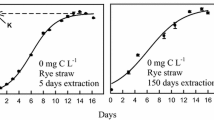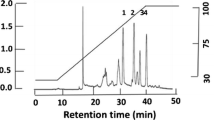Abstract
Rice straw is supposed to be an environment-friendly biomaterial for inhibiting the growth of harmful blooms of the cyanobacterium Microcystis aeruginosa. However, its potential mechanism is not well known. To explore this mechanism, the growth, cell viability (esterase activity, membrane potential, and membrane integrity), photosynthesis, and cell size of M. aeruginosa were determined using flow cytometry and Phyto-PAM after exposure to rice straw extracts (RSE). The results show that doses from 2.0 to 10.0 g/L of RSE efficiently inhibited the alga for 15 days, while the physiologic and morphologic responses of the cyanobacteria were time-dependent. RSE interfered with the cell membrane potential, cell size, and in vivo chlorophyll-a fluorescence on the first day. After 7 days of exposure, RSE was transported into the cytosol, which disrupted enzyme activity and photosynthesis. The cyanobacteria then started to repair its physiology (enzyme activity, photosynthesis) and remained viable, suggesting that rice straw act as an algistatic agent.
Similar content being viewed by others
References
Amor K B, Breeuwer P, Verbaarschot P, Rombout F M, Akermans A D L, De Vos W M, Abee T. 2002. Muliparametric flow cytometry and cell sorting for the assessment of viable, injured, and dead bifidobacterium cells during bile salt stress. Appl. Environ. Microbiol., 68(11): 5 209–5 216.
Anderson D M, Kaoru Y, White A W. 2000. Estimated annual economic impacts from harmful algal blooms (HABs) in the United States. WHOI-2000-11Woods Hole Oceanogr Inst, Woods Hole, Massachusetts. http://www.whoi.edu/redtide/pertinentinfo/Economics_report.pdf. Accessed on 2012-10-10.
Bailey S, Clokie M R, Millard A, Mann N H. 2004. Cyanophage infection and photoinhibition in marine cyanobacteria. Res. Microbiol., 155: 720–725.
Brookes J D, Geary S M, Ganf G G, Burch M D. 2000. Use of FDA and flow cytometry to assess metabolic activity as an indicator of nutrient status in phytoplankton. Mar. Freshwater Res., 51: 817–823.
Choe S, Jung I H. 2002. Growth inhibition of freshwater algae by ester compounds released from rotted plants. J. Ind. Eng. Chem., 8: 297–304.
Chung I M, Ali M, Ahmad A, Chun S C, Kim J T, Sultana S. 2007. Steroidal constituents of rice (Oryza sativa) hulls with algicidal and herbicidal activity against blue-green algae and duckweed. Phytochem. Anal., 18: 133–145.
Daniel E T, Ferrier M D, Armbrester E A, Anlauf K A. 2002. Inhibition of dinoflagellate growth by extracts of barley straw (Hordeum vulgare). J. Appl. Phycol., 14: 275–280.
Emily K P, Tracey L M. 2008. Effects of harmful algal blooms on competitors: allelopathic mechanisms of the red tide dinoflagellate Karenia brevis. Limnol. Oceanogr., 53(2): 531–541.
Feng J, Zhu Q, Wu W Z. 2008. Mechanisms of algal inhibition by rice straw extract. Environ. Sci., 29(12): 3 376–3 381. (in Chinese with English abstract)
Ferrier M, Butler B, Terlizzi D, Lacouture R. 2005. The effects of barley straw on the growth of freshwater algae. Bioresour. Technol., 96: 1 788–1 795.
Gibson M, Welch I, Barrett P R F, Ridge I. 1990. Barley straw as an inhibitor of algal growth II: laboratory studies. J. Appl. Phycol., 2: 241–248.
Hagström J A, Sengco M R, Villareal T A. 2010. Potential methods for managing Prymnesium parvum blooms and toxicity, with emphasis on clay and barley straw: a review. J. Am. Water. Resour. Assoc., 46(1): 187–198.
Jochem F J. 1999. Dark survival strategies in marine phytoplankton assessed by cytometric measurement of metabolic activity with fluorescein diacetate. Mar. Biol., 135(4): 721–728.
Johnson I. 1998. Fluorescent probes for living cells. The Histochemical Journal, 30: 123–140.
Jüttner F, Wu J T. 2000. Evidence of allelochemical activity in subtropical cyanobacterial biofilms of Taiwan. Archiv. Für. Hydrobiologie, 147(4): 505–517.
Lawrence J E, Brussaard C P D, Suttle C A. 2006. Virusspecific responses of Heterosigma akashiwo to infection. Appl. Environ. Microb., 72: 7 829–7 834.
Legrand C, Rengefors K, Fistarol G O, Granėli E. 2003. Allelopathy in phytoplankton-biochemical, ecological and evolutionary aspects. Phycologia, 42(4): 406–419.
Li F M, Hu H Y. 2005. Isolation and characterization of novel antialgal allelochemical from Phragmites communis. Appl. Environ. Microbiol., 71(11): 6 545–6 553.
Liu J S, Yang W D, Gao J. 2007. Inhibitory effects of rice straw and barely straw on the growth on Phaeocystis globosa. Acta Ecological Sinica, 27(11): 4 498–4 505. (in Chinese with English abstract)
Millennium Ecosystem Assessment. 2005. Ecosystems and Human Well-Being: Synthesis. Island Press, Washington DC USA. p.1–15.
Monfort P, Baleux B. 1996. Cell cycle characteristics and changes in membrane potential during growth of Escherichia coli as determined by a cyanine fluorescent dye and flow cytometry. J. Microbiol. Methods, 25(1): 79–86.
Muller S, Ullrich S, Losche A, Loffhagen N, Babel W. 2000. Flow cytometric techniques to characterise physiological states of Acinetobacter calcoaceticus. J. Microbiol. Meth., 40: 67–77.
Murray D, Jefferson B, Jarvis P, Parsons S A. 2010. Inhibition of three algae species using chemicals released from barley straw. Environ. Technol., 31(4): 455–466.
Newman J R, Barrett P R F. 1993. Control of Microcystis aeruginosa by decomposing barley straw. J. Aquat. Plant. Manage., 31: 203–206.
Novo D J, Perlmutter N G, Hunt R H, Shapiro H M. 2000. Multiparameter flow cytometric analysis of antibiotic effects on membrane potential, membrane permeability, and bacterial counts of Staphylococcus aureus and Micrococcus luteus. Antimicrob. Agents Chemother., 44: 827–834.
Pan G, Zou H, Chen H, Yuan X. 2006. Removal of harmful cyanobacterial blooms in Taihu Lake using local soils III. Factors affecting the removal efficiency and an in situ field experiment using chitosan-modified local soils. Environ. Pollut., 141: 206–212.
Park M H, Han M S, Ahn C Y, Kim H S, Yoon B D. 2006. Growth inhibition of bloom — forming cyanobacterium Microcystis aeruginosa by rice straw extract. Lett. Appl. Microbiol., 43: 307–312.
Park M H, Chung I M, Ahmad A, Kim B H, Hwang S J. 2009a. Growth inhibition of unicellular and colonial Microcystis strains (Cyanophyceae) by compounds isolated from rice (Oryza sativa) hulls. Aquat. Bot., 90: 309–314.
Park M H, Kim B H, Chung I M, Hwang S J. 2009b. Selective bactericidal potential of rice (Oryza sativa L. var. japonica) hull extract on Microcystis strains in comparison with green algae and zooplankton. Bull. Environ. Contam. Toxicol., 83: 97–101.
Penyige A, Matkó J, Deák E, Bodnár A, Barabás G. 2002. Depolarization of the membrane potential by β-Lactams as a singal to induce autolysis. Biochem. Biophys. Res. Commun., 290: 1 169–1 175.
Prado R, García R, Rioboo C, Herrero C, Abalde J, Cid A. 2009. Comparison of the sensitivity of different toxicity test endpoints in a microalga exposed to the herbicide paraquat. Environ. Int., 35: 240–247.
Rippka R, Deruelles J, Waterbury J B, Herdman M, Stanier R Y. 1979. Genetic assignments, stain histories and properties of pure culture of cyanobacteria. J. Gen. Microbiol., 111: 1–61.
Schenk M, Raffellini S, Guerrero S, Blanco G A, Alzamora S M. 2011. Inactivation of Escherichia coli, Listeria innocua and Saccharomyces cerevisiae by UV-C light: study of cell injury by flow cytometry. LWT-Food. Sci. Technol., 44: 191–198.
Shapiro H M. 2000. Membrane potential estimation by flow cytometry. Methods, 21: 271–279.
Street M. 1978. Research on the improvement of gravel pits for waterfowl by adding straw. Game. Conserv. Annu. Rev., 10: 56–61.
Suggett D J, Borowitzka M A, Prášil O. 2010. Chlorophyll a Fluorescence in Aquatic Sciences: Methods and Applications. Springer, London. p.427–433.
Thompson P A, Harrison P J, Parslow J S. 1991. Influence of irradiance on cell-volume and carbon quota for 10 species of marine-phytoplankton. J. Phycol., 27: 351–360.
Tiffany L W, Park S W, Vivanco M J. 2004. Biochemical and physiological mechanisms mediated by allelochemicals. Curr. Opin. Plant. Biol., 7: 472–479.
Ueckert J, Breeuwer P, Abee T, Stephens P, Nebe von Caron G, ter Steeg P F. 1995. Flow cytometry applications in physiological study and detection of foodborne microorganisms. Int. J. Food Microbiol., 28: 317–326.
Veldhuis M J W, Kraay G W. 2000. Application of flow cytometry in marine phytoplankton research: current applications and future perspectives. Sci. Mar., 64: 121–134.
Vives-Rego J, Lebaron P, Nebe von Caron G. 2000. Current and future applications of flow cytometry in aquatic microbiology. Fems. Micvrobiol. Rev., 24: 429–448.
Xiao X, Chen Y, Liang X, Lou L, Tang X. 2010. Effects of Tibetan hulless barley on bloom-forming cyanobacterium (Microcystis aeruginosa) measured by different physiological and morphologic parameters. Chemosphere, 81: 1 118–1 123.
Yu J Q, Matsui Y. 1997. Effects of root exudates of cucumber (Cucumis sativus) and allelochemicals on ion uptake by cucumber seedlings. J. Chem. Ecol., 23(3): 817–827.
Yu Y, Kong F, Wang M, Qian L, Shi X. 2007. Determination of short-term copper toxicity in a multispecies microalgal population using flow cytometry. Ecotox. Environ. Safe, 66: 49–56.
Zhang M, Kong F, Tan X, Yang Z, Cao H S, Xing P. 2007a. Biochemical, morphological and genetical variations in Microcystis aeruginosa due to colony disaggregation. World J. Microb. Biot., 23(5): 663–670.
Zhang M, Kong F X, Xing P, Tan X. 2007b. Effects of interspecific interactions between Microcystis aeruginosa and Chlorella pyrenoidosa on their growth and physiology. Int. Rev. Hydrobiol., 92: 281–290.
Author information
Authors and Affiliations
Corresponding author
Additional information
Supported by the National Basic Research Program of China (973 Program) (No. 2008CB418002), the National Major Science and Technology Program for Water Pollution Control and Treatment (No. 2012ZX07103-002), the CAS/SAFEA International Partnership Program for Creative Research Teams of Chinese Academy of Sciences (No. KZZDEW-TZ-08-01), and the National Natural Science Foundation of China (No. 20807043)
Rights and permissions
About this article
Cite this article
Su, W., Hagström, J.A., Jia, Y. et al. Effects of rice straw on the cell viability, photosynthesis, and growth of Microcystis aeruginosa . Chin. J. Ocean. Limnol. 32, 120–129 (2014). https://doi.org/10.1007/s00343-014-3063-0
Received:
Accepted:
Published:
Issue Date:
DOI: https://doi.org/10.1007/s00343-014-3063-0




